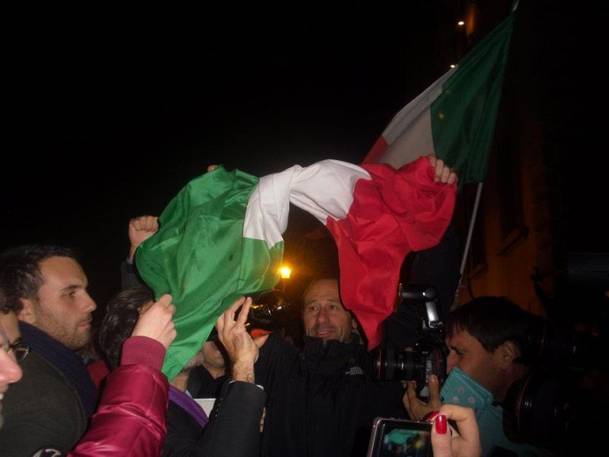


When the news of Berlusconi’s resignation reached me I was on my way to the Guggenheim Museum [2], where all the works by Italian artist Maurizio Cattelan are hanging from the ceiling for a very particular exhibition, “All”.
The museum was packed with Italians, and I was wondering if they had any idea of the latest events happening in their country as they were snapping pictures, flicking through their guidebooks or handling their audio-guide devices on their spiral, ascending walk around the artworks.
My Italian friends, on the other side of the Atlantic, were very busy updating their Facebook statuses, checking in at the Quirinale [3] hill, taking pictures of the jubilating crowd, singing, shouting, throwing coins at Berlusconi’s car on his way back to Palazzo Grazioli.
My understanding of the atmosphere outside the Quirinale is that “Buffone”, buffoon, was the most polite compliment the former premier received. He snuck out of a backdoor of the Quirinale Palace, “just like a piece of s**t” writes Andrea, one of my Facebook contacts. The award for the funniest picture of the day goes to my friend Mariachiara, who was able to capture the facial expression of Emilio Fede, news-anchor for channel Rete 4 and long-time friend of Berlusconi, during the live coverage of the events at the Quirinale. Fede, Berlusconi’s most strenuous defender and fan, looked appalled. His face alone represents the severity of the moment in Italian history.
While many people are already calling the 12th of November the new “Festa della Liberazione” (alluding to April 25, the date when Italy celebrates the end of Mussolini’s dictatorship), I can’t help but thinking of the night when Osama Bin Laden’s death was announced here in the United States.
The same scenes of celebration as in Rome were happening all over the country, the same hype and sense of freedom was filling the hearts of the American people. I believe that in today’s world we have been taught to love and hate symbols, which is a simpler and more exciting thing than devoting our attention to understanding the larger problems they represent.
Berlusconi is an empty symbol. Like Roy Lichtenstein’s painting “IN” exposed at the Guggenheim, with the word “IN” painted in yellow capital letters on a red canvas: the more you look at the painting, the more the word-as-a-word fades into the insignificant. It’s just the icon of a word without meaning. So is Berlusconi today.
“Berlusconismo” is the name Italians gave to the way of dealing with business and politics that has been in fashion since Berlusconi’s power became overwhelming. It’s a philosophy that is now extremely rooted in the way Italians consider power, court it, try to achieve it and maintain it, whatever it takes. That kind of spirit isn’t gone with Berlusconi since yesterday. It will take years for Italy to recover from it, and it would be silly to blame Berlusconi alone for its diffusion. Berlusconism is a malpractice named after a symbol, not just a disease that has finally healed yesterday. Italy’s problems are still here today, and we will see how they will be dealt with from tomorrow.
Valeria, another Facebook friend of mine, made the most interesting remark on the situation: “Now that he’s gone, at least we’ll stop calling prostitutes ‘escorts’ and Mara Carfagna will be able to pose as a calendar girl again”. Right on time for 2012. Funny, isn’t it?
Source URL: http://ftp.iitaly.org/magazine/focus/op-eds/article/young-voice-in-spirit-i-italy
Links
[1] http://ftp.iitaly.org/files/bandiera1321233000jpg
[2] http://www.guggenheim.org
[3] http://www.quirinale.it